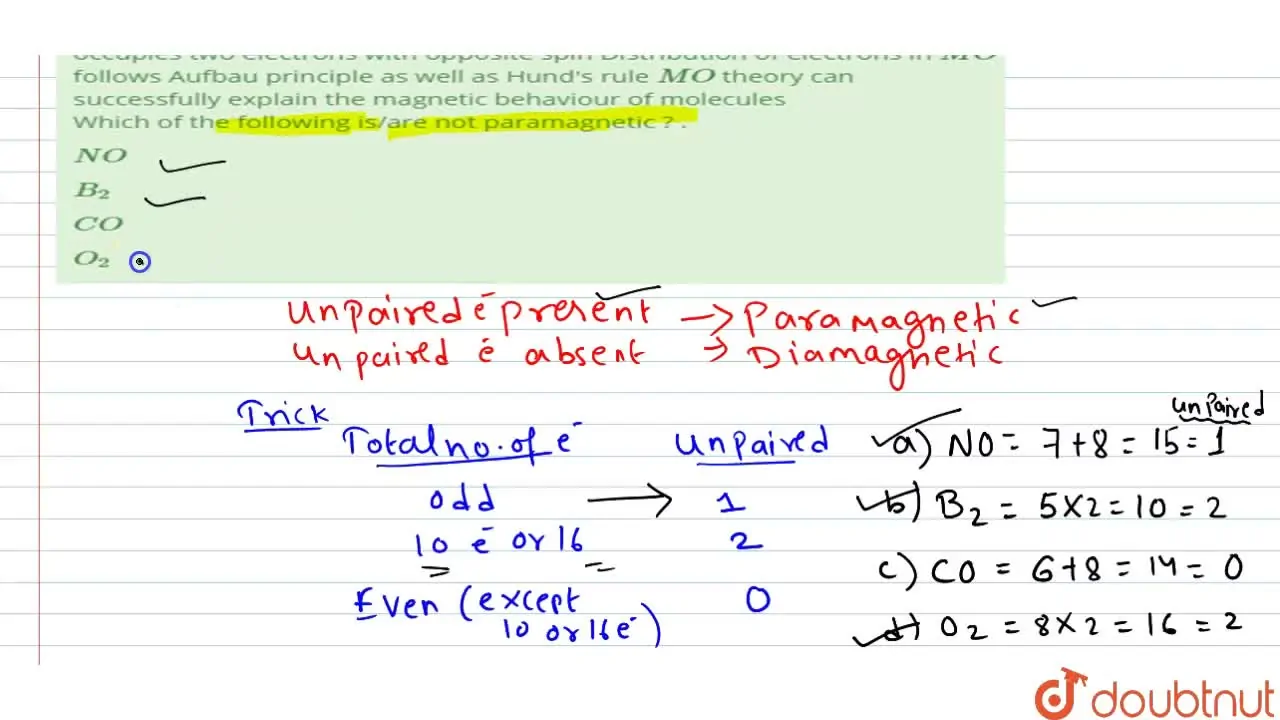According to the moleular orbital theory, all atomic orbitals combine to form molecular orbital by LCAO (linear combination of atomic orbitals) method When two atomic orbitals have additive (constructive) method When two atomic orbitals have additive (constructive) overlapping they form bonding molecular orbitals (BMO) which have lower energy than atomic orbitals whereas when atomic orbitals overlap subtractive higher energy antibonding molecular orbitals (ABMO) are formed Each MO occupies two electrons with opposite spin Distribution of electrons in MO follows Aufbau principle as well as Hund's rule MO theory can successfully explain the magnetic behaviour of molecules
Which of the following is/are not paramagnetic ? .
NO
B2
CO
O2
The correct Answer is:C
Step by step video & image solution for According to the moleular orbital theory, all atomic orbitals combine to form molecular orbital by LCAO (linear combination of atomic orbitals) method When two atomic orbitals have additive (constructive) method When two atomic orbitals have additive (constructive) overlapping they form bonding molecular orbitals (BMO) which have lower energy than atomic orbitals whereas when atomic orbitals overlap subtractive higher energy antibonding molecular orbitals (ABMO) are formed Each MO occupies two electrons with opposite spin Distribution of electrons in MO follows Aufbau principle as well as Hund's rule MO theory can successfully explain the magnetic behaviour of molecules Which of the following is/are not paramagnetic ? . by Chemistry experts to help you in doubts & scoring excellent marks in Class 11 exams.
Related Playlists
- BOOK - CENGAGE CHEMISTRY ENGLISHCHAPTER - CHEMICAL BONDING AND MOLECULAR STRUCTUREEXERCISE - Exercises Multiple Correct(Chemical Bonding )7videos
CHEMICAL BONDING AND MOLECULAR STRUCTURE
- BOOK - CENGAGE CHEMISTRY ENGLISHCHAPTER - CHEMICAL BONDING AND MOLECULAR STRUCTUREEXERCISE - Exercises Multiple Correct (Dipole Moment)3videos
CHEMICAL BONDING AND MOLECULAR STRUCTURE
- BOOK - CENGAGE CHEMISTRY ENGLISHCHAPTER - CHEMICAL BONDING AND MOLECULAR STRUCTUREEXERCISE - Ex 2 .2 Objective34videos
CHEMICAL BONDING AND MOLECULAR STRUCTURE
- BOOK - CENGAGE CHEMISTRY ENGLISHCHAPTER - ATOMIC STRUCTUREEXERCISE - Concept Applicationexercise(4.3)19videos
ATOMIC STRUCTURE
- BOOK - CENGAGE CHEMISTRY ENGLISHCHAPTER - CHEMICAL EQUILIBRIUMEXERCISE - Subjective type1videos
CHEMICAL EQUILIBRIUM
Similar Questions
According to the moleular orbital theory, all atomic orbitals combine to form molecular orbital by LCAO (linear combination of atomic orbitals) method When two atomic orbitals have additive (constructive) method When two atomic orbitals have additive (constructive) overlapping they form bonding molecular orbitals (BMO) which have lower energy than atomic orbitals whereas when atomic orbitals overlap subtractive higher energy antibonding molecular orbitals (ABMO) are formed Each MO occupies two electrons with opposite spin Distribution of electrons in MO follows Aufbau principle as well as Hund's rule MO theory can successfully explain the magnetic behaviour of molecules
Bond strength increases whenView SolutionAccording to molecular orbital theory,
View SolutionWhich type of atomic orbitals can overlap to from molecular orbitals ?
View SolutionExplain bonding and antibonding molecular orbitals.
View SolutionThe possible molecular orbital formed when two d-orbitals overlap is .
View SolutionWhen two atomic orbitals linearly combine, they form
View SolutionDescribe molecular orbital. How is it different from an atomic orbital?
View SolutionDistinguish two aspects of bonding and antibonding molecular orbitals.
View SolutionHow many molecular orbitals are formed by the combination of two lithium atoms?
View SolutionWrite the important conditions required for the linear combination of atomic orbitals to form molecular orbitals.
View Solution


